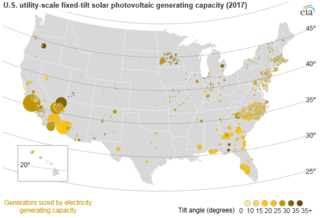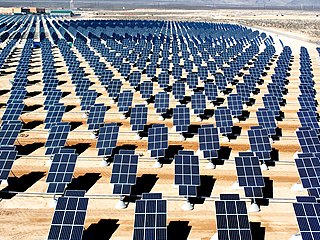
ActewAGL is an Australian multi-utility joint venture company that provides utility services in the Australian Capital Territory (ACT) and south-east New South Wales. The company was formed in October 2000 between the Australian Gas Light Company and ACTEW Corporation, an ACT Government-owned corporation.

Nevada Solar One is a concentrated solar power plant, with a nominal capacity of 64 MW and maximum steam turbine power output up to 72 MW net (75 MW gross), spread over an area of 400 acres (160 ha). The projected CO2 emissions avoided is equivalent to taking approximately 20,000 cars off the road. The project required an investment of $266 million USD, and the project officially went into operation in June 2007. Electricity production is estimated to be 134 GWh (gigawatt hours) per year.

According to preliminary data from the US Energy Information Administration, renewable energy accounted for about 12.6% of total primary energy consumption and about 19.8% of the domestically produced electricity in the United States in 2020.

RechargeIT is one of five initiatives within Google.org, the charitable arm of Google, created with the aim to reduce CO2 emissions, cut oil use, and stabilize the electrical grid by accelerating the adoption of plug-in electric vehicles.

Engie SA is a French multinational utility company, headquartered in La Défense, Courbevoie, which operates in the fields of energy transition, electricity generation and distribution, natural gas, nuclear, renewable energy and petroleum.

Solar power in the United States includes utility-scale solar power plants as well as local distributed generation, mostly from rooftop photovoltaics. As of the end of 2021, the United States had 121,475 megawatts (MW) of installed photovoltaic and concentrated solar power capacity combined. In 2018, utility-scale solar power generated 66.6 terawatt-hours (TWh), 1.66% of total U.S. electricity. During the same time period total solar generation, including estimated small-scale photovoltaic generation, was 96.1 TWh, 2.30% of total U.S. electricity. In terms of total cumulative installed capacity, by year end 2017 the United States ranked 2nd in the world behind China. In 2016, 39% of all new electricity generation capacity in the country came from solar, more than any other source and ahead of natural gas (29%). By 2015, solar employment had overtaken oil and gas as well as coal employment in the United States. In 2016, more than 260,000 Americans were employed in the solar industry.

eSolar is a privately held company that develops concentrating solar power (CSP) plant technology. The company was founded by the Pasadena-based business incubator Idealab in 2007 as a developer of CSP plant technology. The company aims to develop a low cost alternative to fossil fuels through a combination of small heliostats, modular architecture, and a high-precision sun-tracking system. In October 2017, an article in GreenTech Media suggested that eSolar ceased business in late 2016.
Wind resource assessment is the process by which wind power developers estimate the future energy production of a wind farm. Accurate wind resource assessments are crucial to the successful development of wind farms.
WattzOn is a privately held SaaS company that helps users in the U.S. learn how to save energy, in collaboration with cities and other business partners, through personalized plans, product and rebate information, and tips for habit changes. WattzOn provides nationwide capture of residential utility data, and they claim that a typical user saves nearly $240 per year in energy, and that their water programs save an average of 9,000 gallons per year.

Solar power in Nevada is growing due to a Renewable Portfolio Standard which requires 20% renewable energy by 2015, and 5% from solar power. The state has abundant open land areas and some of the best solar potential in the country.
The International Hydropower Association (IHA) is a non-profit, international organisation and membership association representing the global hydropower sector. IHA has members in more than 80 countries, including over 100 corporate and affiliate members working across sectors such as electricity generation, water management, construction, engineering and related industries. IHA also partners with international organisations, research institutions, governments and civil society. The association's mission is "to advance sustainable hydropower by building and sharing knowledge on its role in renewable energy systems, freshwater management and climate change solutions".
Different methods of electricity generation can incur a variety of different costs, which can be divided into three general categories: 1) wholesale costs, or all costs paid by utilities associated with acquiring and distributing electricity to consumers, 2) retail costs paid by consumers, and 3) external costs, or externalities, imposed on society.

EPB of Chattanooga, formerly known as the Electric Power Board of Chattanooga, is an American electric power distribution and telecommunications company owned by the city of Chattanooga, Tennessee. EPB serves nearly 180,000 homes and businesses in a 600-square mile area in the greater Chattanooga area and Hamilton County. In 2010, EPB was the first company in the United States to offer 1 Gbit/s high-speed internet, over 200 times faster than the national average over a fiber optic network. As a result, Chattanooga has been called "Gig City" and held up as a national model for deploying the world's fastest internet and the most advanced Smart Grid electric distribution system in the United States. On October 15, 2015, Chattanooga implemented the world's first community-wide 10-gig Internet service.

Solar power in Louisiana is ranked 34th for installed solar PV capacity as of 2017 by the Solar Energy Industry Association. The state's "solar friendliness" according to Solar Power Rocks has fallen to 50th place for 2018 as the state credit program ends and full 1:1 retail net metering is being phased out. Taxpayers still benefit from federal incentive programs such as the 30 percent tax credit, which applies to business and residential solar photovoltaic and thermal energy systems of any size.

Most of Kenya's electricity is generated by renewable energy sources. On 13 December 2019, Kenya brought online a new 50 megawatt (MW) solar plant in Turkana at the cost of $129 million, bringing her renewable energy to 90% of its power mix. With an installed power capacity of 2,336 MW, Kenya generates 870 MW hydroelectric power, 706 MW geothermal power, 253.5 MW thermal power and the rest from other sources. Kenya is the largest geothermal energy producer in Africa and was also the first geothermal-producing state in Africa when Olkaria I Power Station was commissioned in 1981, generating 45 MW. Seventy three percent (73%) of Kenyan households have electricity access. Currently, Kenya is building Olkaria I Unit 6 which will produce an additional 83 MW to the grid making it the 7th largest geothermal power producer in the world. Additionally, Kenya has the largest wind farm project in Africa with the Lake Turkana Wind Project Power Project. In March 2011, Kenya became the first country in Africa to open a carbon exchange, presenting 17 projects for registration to the U.N. Kyoto Protocol's Clean Development Mechanism executive board. Kenya is also a signatory to the Paris Agreement and targets to reduce carbon emissions by 30% below business as usual by 2030 as determined in the Nationally Determined Contribution (NDC). The Renewable Energy Directorate under the Ministry of Energy is responsible for research and development of renewable energy technologies.
The U.S. state of Arkansas is a significant producer of natural gas and a minor producer of petroleum.
Octopus Energy Group is a British renewable energy group specialising in sustainable energy. It was founded in 2015 with the backing of British fund management company Octopus Group, a British asset management company. Headquartered in London, the company has operations in the UK, France, Germany, Italy, Spain, Australia, Japan, New Zealand and the United States. As of September 2021 the company has over three million domestic and business customers, making it the fourth largest energy supplier in the UK.

The Global Solar Atlas (GSA) is a free, online, map-based application that provides information on solar resource and photovoltaic power potential globally. It features the online interactive map tools, simplified photovoltaic (PV) power calculator, reporting tools and the extensive download section. It is intended to provide policy makers, academia, and renewable energy stakeholders to raise awareness in the solar energy domain, support the development of policies and plans, and for initial zoning and site identification purposes.
Kodeni Solar Power Station, is a 38 MW (51,000 hp) solar power plant, under construction in Burkina Faso. The solar farm is under development by the French IPP, Africa Ren, with funding from European financial institutions, led by FMO Entrepreneurial Development Bank of the Netherlands. Société Nationale d'électricité du Burkina Faso (SONABEL), the state-owned electricity utility company has signed a 25-year power purchase agreement (PPA), with Koden Solar SASU, the special purpose vehicle company established by the owners to own, develop, operate and maintain the solar farm.












